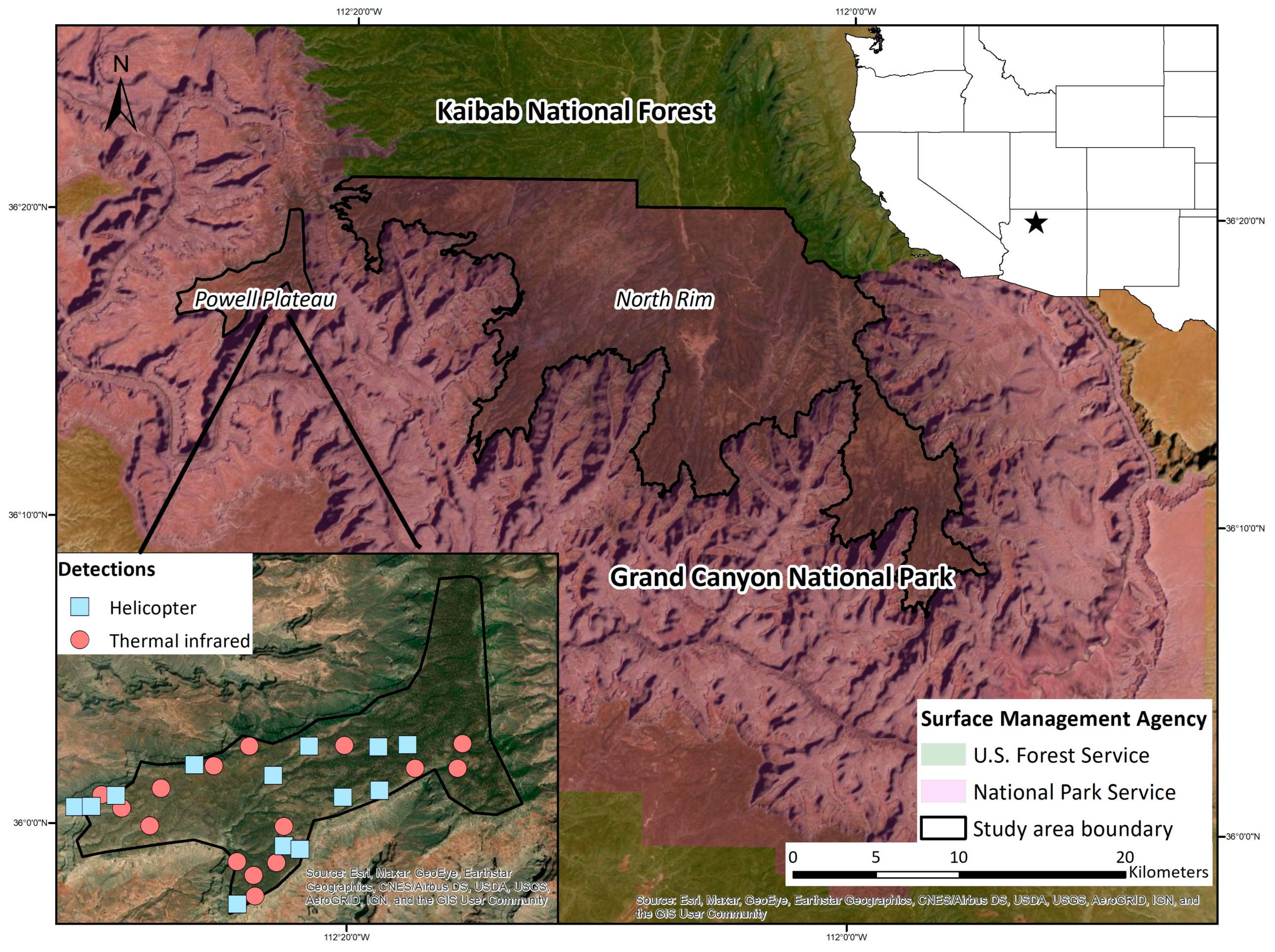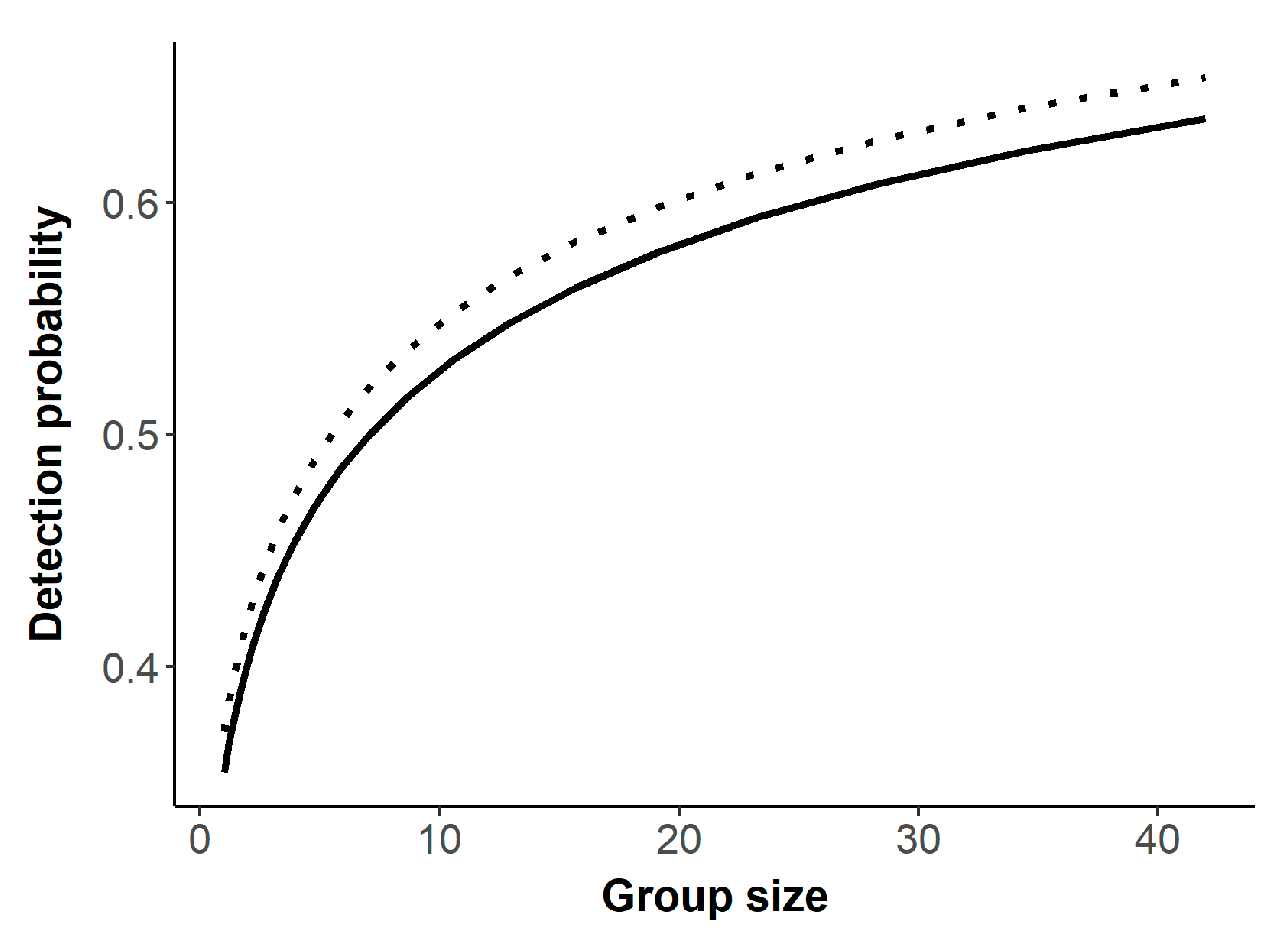Comparison of Aerial Thermal Infrared Imagery and Helicopter Surveys of Bison (Bison bison) in Grand Canyon National Park, USA
Abstract
:1. Introduction
2. Materials and Methods
Statistical Analysis
3. Results
4. Discussion
Author Contributions
Funding
Institutional Review Board Statement
Informed Consent Statement
Data Availability Statement
Acknowledgments
Conflicts of Interest
References
- Rabe, M.J.; Rosenstock, S.S.; deVos, J.C., Jr. Review of big-game survey methods used by wildlife agencies of the western United States. Wildl. Soc. Bull. 2002, 30, 46–52. [Google Scholar]
- Schoenecker, K.A.; Lubow, B.C. Application of a hybrid model to reduce bias and improve precision in population estimates for elk (Cervus elaphus) inhabiting a cold desert ecosystem. J. King Saud Univ. Sci. 2016, 28, 205–215. [Google Scholar] [CrossRef] [Green Version]
- Cilulko, J.; Janiszewski, P.; Bogdaszewski, M.; Szczygielska, E. Infrared thermal imaging in studies of wild animals. Eur. J. Wildl. Res. 2013, 97, 17–23. [Google Scholar] [CrossRef] [Green Version]
- Baratchi, M.; Meratnia, N.; Havinga, P.J.M.; Skidmore, A.K.; Toxopeus, B.A.G. Sensing solutions for collecting spatio-temporal data for wildlife monitoring applications: A review. Sensors 2013, 13, 6054–6088. [Google Scholar] [CrossRef] [PubMed] [Green Version]
- Kinzel, P.J.; Nelson, J.M.; Parker, R.S.; Davis, L.R. Spring census of mid-continent sandhill cranes using aerial infrared videography. J. Wildl. Manag. 2006, 70, 70–77. [Google Scholar] [CrossRef]
- Kissell, R.E., Jr.; Nimmo, S.K. A technique to estimate white-tailed deer Odocoileus virginianus density using vertical-looking infrared imagery. Wildl. Biol. 2011, 17, 85–92. [Google Scholar] [CrossRef] [Green Version]
- Gillette, G.L.; Coates, P.S.; Petersen, S.; Romero, J.P. Can reliable sage-grouse lek counts be obtained using aerial infrared technology? J. Fish Wildl. Manag. 2013, 4, 386–394. [Google Scholar] [CrossRef] [Green Version]
- Beaver, J.T.; Harper, C.A.; Kissell, R.E., Jr.; Mullier, L.I.; Basinger, P.S.; Goode, M.J.; Van Manen, F.T.; Winton, W.; Kennedy, M.L. Aerial vertical-looking infrared imagery to evaluate bias of distance sampling techniques for white-tailed deer. Wildl. Soc. Bull. 2014, 38, 419–427. [Google Scholar] [CrossRef]
- Schoenecker, K.A.; Doherty, P.F., Jr.; Hourt, J.S.; Romero, J.P. Testing infrared camera surveys and distance analyses to estimate feral horse abundance in a known population. Wildl. Soc. Bull. 2018, 42, 452–459. [Google Scholar] [CrossRef]
- Bernatas, S.; Nelson, L. Sightability model for California bighorn sheep in canyonlands using forward-looking infrared (FLIR). Wildl. Soc. Bull. 2005, 32, 638–647. [Google Scholar] [CrossRef]
- Grierson, I.T.; Gammon, J.A. The use of digital imagery for kangaroo monitoring. Geocarto Int. 2002, 17, 45–52. [Google Scholar] [CrossRef]
- Lethbridge, M.; Stead, M.; Wells, C. Estimating kangaroo density by aerial survey: A comparison of thermal cameras with human observers. Wildl. Res. 2019, 46, 639–648. [Google Scholar] [CrossRef]
- Plumb, G.; McMullen, C. Bison on the southwest Colorado Plateau: Conservation at the edge. Southwest. Nat. 2018, 63, 42–48. [Google Scholar] [CrossRef]
- Reimondo, E.L. Ecological Impacts and Management Implications of Introduced Bison in the Grand Canyon. Master’s Thesis, Northern Arizona University, Flagstaff, AR, USA, 2012. [Google Scholar]
- Plumb, G.E.; Sturm, M.; McMullen, C.; Holm, G.; Lutch, C.; Keckler, C.; Gatto, A.; Munig, A.; Wallen, R. Grand Canyon Bison Nativity, Genetics, and Ecology: Looking Forward; Natural Resource Report NPS/NRSS/BRD/NRR–2016/1226; National Park Service: Fort Collins, CO, USA, 2016.
- Terwilliger, M.L.N.; Hartway, C.R.; Schoenecker, K.A.; Holm, G.; Zeigenfuss, L.C.; Swan, M.; Salganek, D.S.; Buttke, D.; Musto, D.T. Management of the Kaibab Plateau bison herd in Grand Canyon National Park: 2018–2019 Operations Report; Natural Resource Report NPS/GRCA/NRR–2020/2167; National Park Service: Fort Collins, CO, USA, 2020.
- Lubow, B.C.; Ransom, J.I. Practical bias correction in aerial surveys of large mammals: Validation of hybrid double-observer with sightability methods against known abundance of feral horse (Equus caballus) population. PLoS ONE 2016, 11, e0154902. [Google Scholar] [CrossRef] [PubMed]
- U.S. Geological Survey. The National Map. Available online: https://apps.nationalmap.gov/downloader/#/ (accessed on 15 November 2020).
- Hennig, J.D.; Schoenecker, K.A. Detections of Bison from Helicopter and Aerial Thermal Infrared Imagery in Grand Canyon National Park, 2019–2021; U.S. Geological Survey data release; Fort Collins Science Center: Fort Collins, CO, USA, 2021. [CrossRef]
- Schoenecker, K.A.; Lubow, B.C.; Johnson, T.L. Development of an Aerial Population Survey Method for Elk in Rocky Mountain National Park, Colorado; U.S. Geological Survey Open-File Report 2018-1085; USGS: Reston, VA, USA, 2018; 45p.
- Griffin, P.C.; Ekernas, L.S.; Schoenecker, K.A.; Lubow, B.C. Standard Operating Procedures for Wild Horse and Burro Double-Observer Aerial Surveys: U.S. Geological Survey Techniques and Methods; USGS: Reston, VA, USA, 2020; Chapter A16; 76p.
- Griffin, P.C.; Lubow, B.C.; Jenkins, K.J.; Vales, D.J.; Moeller, B.J.; Reid, M.; Happe, P.J.; McCorquodale, S.M.; Tirhi, M.J.; Schaberl, J.P.; et al. A hybrid double-observer sightability model for aerial surveys. J. Wildl. Manag. 2013, 77, 1532–1544. [Google Scholar] [CrossRef]
- Laake, J.L.; Johnson, D.S.; Diefenbach, D.R.; Ternent, M.A. Hidden Markov model for dependent mark loss and survival estimation. J. Agric. Biol. Environ. Stat. 2014, 19, 522–538. [Google Scholar] [CrossRef]
- Borchers, D.L.; Laake, J.L.; Southwell, C.; Paxton, C.G.M. Accommodating unmodeled heterogeneity in double-observer distance sampling surveys. Biometrics 2006, 62, 372–378. [Google Scholar] [CrossRef]
- Huggins, R.M. On the statistical analysis of capture-recapture experiments. Biometrika 1989, 76, 133–140. [Google Scholar] [CrossRef]
- Huggins, R.M. Some practical aspects of a conditional likelihood approach to capture experiments. Biometrics 1991, 47, 725–732. [Google Scholar] [CrossRef]
- Laake, J.L. RMark: An R Interface for Analysis of Capture-Recapture Data with MARK; AFSC Processed Report 2013-01; NOAA: Seattle, WA, USA, 2013; p. 25.
- Laake, J. DoubleObs: Analysis of Double-Observer Survey Data. R Package Version 0.1.3. 2021. Available online: https://github.com/jlaake/DoubleObs (accessed on 22 June 2021).
- R Core Team. R: A Language and Environment for Statistical Computing; R Foundation for Statistical Computing: Vienna, Austria, 2021. [Google Scholar]
- Burnham, K.P.; Anderson, D.R. Model Selection and Multi-Model Inference: A Practical Information-Theoretic Approach, 2nd ed.; Springer: New York, NY, USA, 2002. [Google Scholar]
- Kellner, K.F.; Swihart, R.K. Accounting for imperfect detection in ecology: A quantitative review. PLoS ONE 2014, 9, e111436. [Google Scholar] [CrossRef] [Green Version]
- Laake, J.L.; Collier, B.A.; Morrison, M.L.; Wilkins, R.N. Point-based mark-recapture distance sampling. J. Agric. Biol. Environ. Stat. 2011, 16, 389–408. [Google Scholar] [CrossRef]
- Fretwell, P.T.; LaRue, M.A.; Morin, P.; Kooyman, G.L.; Wienecke, B.; Ratcliffe, N.; Fox, A.J.; Fleming, A.H.; Porter, C.C.; Trathan, P.N. The first global, synoptic survey of a species from space: Emperor penguins. PLoS ONE 2012, 7, e33751. [Google Scholar] [CrossRef]
- Yifei, X.; Wang, T.; Skidmore, A.K. Automatic counting of large mammals from very high resolution panchromatic satellite imagery. Remote Sens. 2017, 9, 878. [Google Scholar]
- Höschle, C.; Cubaynes, H.C.; Clarke, P.J.; Humphries, G.; Borowicz, A. The potential of satellite imagery for surveying whales. Sensors 2021, 21, 963. [Google Scholar] [CrossRef] [PubMed]
- LaRue, M.A.; Stapleton, S.; Anderson, M. Feasibility of using high-resolution satellite imagery to assess vertebrate wildlife populations. Conserv. Biol. 2016, 31, 213–220. [Google Scholar] [CrossRef]


| Observer | Groups Detected | Individuals Counted |
|---|---|---|
| Helicopter-frontseat observers | 4 | 38 |
| Helicopter-backseat observers | 13 | 127 |
| Thermal infrared-observer 1 | 15 | 101 |
| Thermal infrared-observer 2 | 14 | 100 |
| Model | K | AICc | ΔAICc | wi |
|---|---|---|---|---|
| Thermal infrared-Powell | ||||
| Observer a | 2 | 23.62 | 0.00 | 0.58 |
| Observer + type b | 3 | 24.25 | 0.63 | 0.42 |
| Helicopter-Powell | ||||
| Observer | 2 | 26.98 | 0.00 | 0.59 |
| Observer + recapture c | 3 | 27.68 | 0.70 | 0.41 |
| Helicopter-Pooled surveys | ||||
| Observer + recapture + groupsize d | 4 | 200.10 | 0.00 | 0.45 |
| Observer + recapture + groupsize + forest e | 5 | 201.74 | 1.64 | 0.20 |
| Observer + recapture | 3 | 201.88 | 1.78 | 0.18 |
| Observer + recapture + forest | 4 | 203.63 | 3.53 | 0.08 |
| Observer + groupsize | 3 | 204.98 | 4.88 | 0.04 |
| Observer | 2 | 205.86 | 5.75 | 0.03 |
| Observer + groupsize + forest | 4 | 206.70 | 6.60 | 0.02 |
| Observer + forest | 3 | 207.72 | 7.62 | 0.00 |
| Method | Count | Estimate | SE | LCL | UCL |
|---|---|---|---|---|---|
| Thermal infrared-Powell | 101 | 131 | 4 | 130 | 155 |
| Helicopter-Powell | 127 | 147 | 20 | 137 | 283 |
| Helicopter-Pooled surveys | 127 | 162 | 24 | 141 | 258 |
Publisher’s Note: MDPI stays neutral with regard to jurisdictional claims in published maps and institutional affiliations. |
© 2021 by the authors. Licensee MDPI, Basel, Switzerland. This article is an open access article distributed under the terms and conditions of the Creative Commons Attribution (CC BY) license (https://creativecommons.org/licenses/by/4.0/).
Share and Cite
Hennig, J.D.; Schoenecker, K.A.; Terwilliger, M.L.N.; Holm, G.W.; Laake, J.L. Comparison of Aerial Thermal Infrared Imagery and Helicopter Surveys of Bison (Bison bison) in Grand Canyon National Park, USA. Sensors 2021, 21, 5087. https://doi.org/10.3390/s21155087
Hennig JD, Schoenecker KA, Terwilliger MLN, Holm GW, Laake JL. Comparison of Aerial Thermal Infrared Imagery and Helicopter Surveys of Bison (Bison bison) in Grand Canyon National Park, USA. Sensors. 2021; 21(15):5087. https://doi.org/10.3390/s21155087
Chicago/Turabian StyleHennig, Jacob D., Kathryn A. Schoenecker, Miranda L.N. Terwilliger, Gregory W. Holm, and Jeffrey L. Laake. 2021. "Comparison of Aerial Thermal Infrared Imagery and Helicopter Surveys of Bison (Bison bison) in Grand Canyon National Park, USA" Sensors 21, no. 15: 5087. https://doi.org/10.3390/s21155087
APA StyleHennig, J. D., Schoenecker, K. A., Terwilliger, M. L. N., Holm, G. W., & Laake, J. L. (2021). Comparison of Aerial Thermal Infrared Imagery and Helicopter Surveys of Bison (Bison bison) in Grand Canyon National Park, USA. Sensors, 21(15), 5087. https://doi.org/10.3390/s21155087






